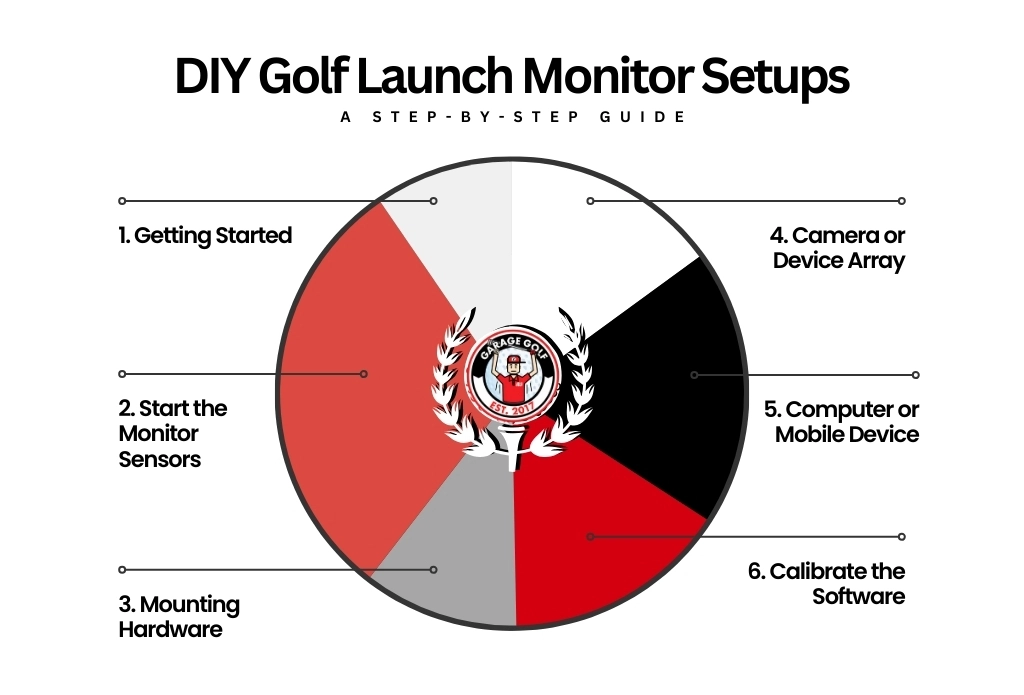Forget about spending a fortune on flashy DIY golf launch monitor setups! If you are excited about the game of golf and eager to improve your game on a budget, the DIY route can be a compelling substitute. Put on your seatbelts because this blog post will guide you in transforming your setup for golf based on extensive research about building on a budget.
We will break down the entire process step-by-step and help you build your own launch monitor setup and unlock valuable swing insights without making financial compromises. Launch monitors give information related to clubhead speed, launch angle, and ball speed. In this guide, we will help you create a home setup to gather your materials, let your imagination run wild, and get ready to enjoy the excitement of creating your own shot tracking!
Step 1: Access Space Requirements:
Before entering into the setup process, it is essential to access the space available for your DIY golf launch monitor setup. Ideally, you’ll need a dedicated area with enough room to swing a club comfortably without risking damage to surrounding objects. A garage, basement, or spare room can work well for this purpose. Ensure that the space has adequate lighting and ventilation for a comfortable practice environment.
Step 2: Collect Necessary Equipment:
To create your best golf launch monitor setup, you will need the following equipment:
- Launch Monitor: Choose a launch monitor that fits your budget and requirements. Options range from basic models that measure essential metrics to more advanced units with features like ball spin analysis and club fitting capabilities. A nice budget option would be something like the Garmin R10 or Skytrak Launch Monitor.
- Hitting Mat: Invest in a quality hitting mat to simulate the feel of real turf and protect your joints and elbows from repeated use as well as your flooring from club damage. One of our favorite options is the SIGPRO Softy Golf Mat. Another option for the extreme DIY’er would be to buy the SIGPRO Softy Hitting Strip and drop it into an existing subfloor or golf mat to save even more money. For those who want a slightly cheaper full mat setup take a look at the Carl’s Place Hotshot Golf Mats as well.
- Netting or Screen: To capture balls safely during practice sessions, set up netting or a screen in front of your hitting area. This will prevent balls from damaging walls or windows and create a designated target zone for your shots.
- Projector and Screen: For a more immersive experience, consider adding a projector and screen to display shot data and virtual golf courses. This setup can enhance the realism of your practice sessions and make tracking progress more engaging. One of our favorite budget projectors is the Optoma GT2000 HDR that is an ultra short throw option. You will want to keep that projector in line with a traditional 4:3 ratio. One of the best screen options out there to consider is the SIGPRO Premium Screen by The Indoor Golf Shop.
Step 3: Set Up the Launch Monitor:
Once you have collected all your necessary equipment, it is time to install the golf launch monitor software. Here are some of the following steps:
- Position the launch monitor according to the manufacturer’s instructions, ensuring that it has a clear line of sight to the hitting area or ball as required by the device.
- Connect the launch monitor to a power source and any additional devices, such as a computer or smartphone, for data analysis and display.
- Calibrate the launch monitor according to the provided guidelines to ensure accurate measurements of shot data.
Step 4: Set Up the Hitting Area:
With the launch monitor in place, it’s time to set up your hitting area for practice. Follow these steps:
- Place the hitting mat in the desired location. Make sure that it provides a level surface for swinging.
- Position the netting or screen in front of the hitting area to capture balls and protect surrounding surfaces.
- If using a projector and screen, install them in a location where shot data and virtual courses are easily visible during practice and in a location where the golfer’s shadow will not block the screen. For throw ratios and mounting distances on any projector options you are considering, we recommend taking a look at this handy tool from our friends at ProjectorCentral.com.
Step 5: Test and Adjust:
Once everything is set up, take some test shots to ensure that the golf launch monitor is accurately capturing shot data. Make any necessary adjustments to the positioning or settings of the launch monitor to optimize performance.
Carefully follow the setup guide or instructions for your chosen launch monitor. Most launch monitors have a calibration process. Always make sure you do this accurately. Take some practice test swings to check if the data is realistic.
Step 6: Practice and Analyze:
With your DIY golf launch monitor setups complete, now it is time to start practicing. Use the sort data provided by the launch monitor to analyze your swings, identify areas for improvement, and track your progress over time. Experiment with different clubs, swing techniques, and course conditions to refine your skills and lower your scores on the course.
Consider some of the features like lighting, background, and placements. Good lighting is important for camera-based launch monitors. A plain background behind your netting if hitting into a net can also help radar based systems more accurately track the ball. Place the launch monitor according to manufacturer instructions for optimal accuracy.
More Additional Tips:
- Start in a simple manner with a computer monitor or even a tablet setup for ease of use.
- Research properly and choose components that are based on your budget, technical skills, and desired data points.
- Join some online communities, get help, and share experiences with other enthusiasts.
- Consider some inbuilt options. Various companies offer “DIY-lite” kits with easier assembly and calibration.
- Make sure that if using a swing camera or cell phone camera to record your swing that it has a high-quality level and has a clear view of the path of the ball.
Always keep safety and reasonable expectations in mind. Although it may not be a perfect substitute for commercial equipment, assembling a DIY Golf Launch Monitor Setups may be an enjoyable and fruitful endeavour that provides insightful information about your swing.
Conclusion:
Creating your own golf launch monitor setup may seem like a difficult task at first, but with the appropriate resources and expertise it is entirely achievable for the average golfer. You don’t have to spend a fortune on pricey commercial systems to take advantage of accurate shot tracking and analysis. All you need to do is follow the instructions in this article and devote some time and energy to calibration and setup.
Without spending a fortune on pricey professional equipment, creating a homemade golf launch monitor setup can give you insightful information about your game and assist you in making significant changes. You may be able to set up a practice area at home now where you can improve your game and fully enjoy the game of golf. So why wait? Raise your game by constructing your own DIY golf simulator launch monitor setup with Garage Golf right now!

